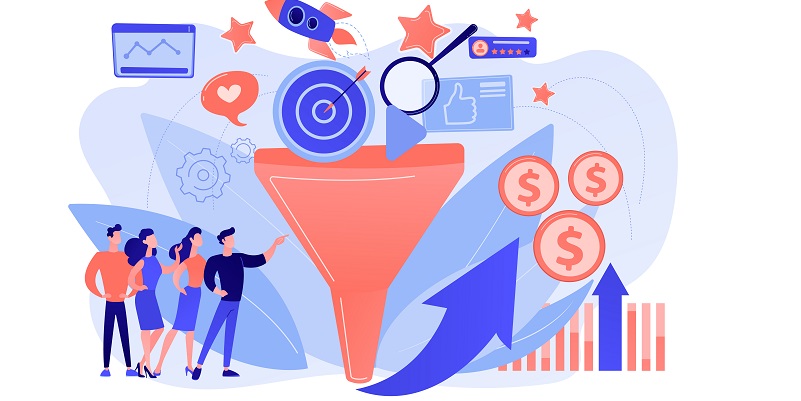In today’s competitive business landscape, understanding the customer journey is crucial for companies to achieve success. Sales funnels play a significant role in this process, providing valuable insights into sales leads. By identifying bottlenecks and tailoring strategies at each stage, businesses can optimize conversions and drive revenue growth.
Understanding the Sales Funnel
A sales funnel represents the customer’s path from initial awareness to making a purchase. It consists of four key stages:
1. Top of the funnel (TOFU): In this stage, the primary focus is on attracting a large audience of potential customers. The goal is to generate sales leads that can be nurtured throughout the funnel.
2. Middle of the funnel (MOFU): Once prospects enter the funnel, the focus shifts to nurturing their interest and engagement. This stage involves actions such as signing up for newsletters, downloading free trials, and contacting relevant teams for more information.
Bottom of the funnel (BOFU): At this stage, prospects are ready to make a purchase decision. Companies must employ effective conversion techniques to turn prospects into paying customers.
4. Purchase phase: In the final stage, prospects become paying customers, culminating in a successful conversion.
Tailoring strategies to improve conversion
To optimize conversion rates, SaaS companies must identify bottlenecks in their sales funnels. By analyzing data, companies can understand the specific areas where prospects drop off and make necessary adjustments. This may involve refining messaging, improving user experience, or addressing any concerns or objections customers may have.
Focusing on prospects most likely to convert
One advantage of a SaaS sales funnel is the ability to identify the prospects most likely to convert from free trials or freemium products into paying customers. By nurturing these leads with targeted marketing efforts and personalized communication, companies can increase conversion rates and reduce customer churn.
Attracting a large audience at the top of the funnel
At the top of the sales funnel, generating sales leads is of utmost importance. SaaS companies should focus on creating brand awareness and attracting a wide audience. Strategies may include content marketing, search engine optimization (SEO), social media campaigns, and targeted advertising. The goal is to cast a wide net and capture the attention of potential customers.
Nurturing prospects in the middle of the funnel
As prospects move through the funnel, it is essential to nurture their interest and engagement. This stage involves providing valuable content, addressing pain points, and showcasing the unique value of the product or service. SaaS companies often face competition at this stage, and offering free trials can help prospects experience the full value of the product, giving them an edge in the decision-making process.
The final phase of the sales funnel
In the purchase phase, prospects have done their research, compared alternatives, and are ready to make a decision. Companies should ensure a seamless buying experience, removing any barriers or friction points that may hinder the conversion process. Streamlining the purchase process, offering attractive pricing options, and providing excellent customer support are crucial factors at this stage.
Importance of Effective Conversion Techniques
To improve conversion rates, SaaS companies can employ various tactics such as personalized email marketing, targeted offers or discounts, limited-time promotions, and upselling or cross-selling strategies. By leveraging data analytics and customer insights, companies can tailor their approach to maximize conversions.
Explanation of Interconnection
While sales funnels focus on the customer journey and optimizing conversions, sales pipelines are more concerned with metrics such as setting sales targets, budgeting, and forecasting. Both are critical components of a successful sales strategy, requiring seamless coordination for maximum effectiveness.
Strategies for SaaS companies to optimize sales funnels
For early-stage SaaS companies, establishing brand awareness is essential before launching aggressive product promotion. Building brand identity through content marketing, thought leadership, and engaging with target audiences on social media platforms helps create a positive reputation and trust.
1. Keyword optimization: Conduct thorough keyword research to align content with search intent, improving organic reach and visibility in search engine results.
2. Establishing authority and credibility: Leverage various platforms, including industry publications, guest blogging, and social media, to showcase expertise, share insights, and build trust with the target audience.
SaaS sales funnels play a crucial role in optimizing conversion rates and driving revenue growth. By understanding the stages of the sales funnel and implementing effective strategies, companies can attract a larger audience, nurture prospects, turn them into paying customers, and increase their bottom line. Remember, the key lies in tailoring efforts throughout the funnel, adjusting strategies based on insights and data analysis, and continuously optimizing the customer journey. With an optimized sales funnel, SaaS companies can unlock their full potential and achieve sustainable business success.

